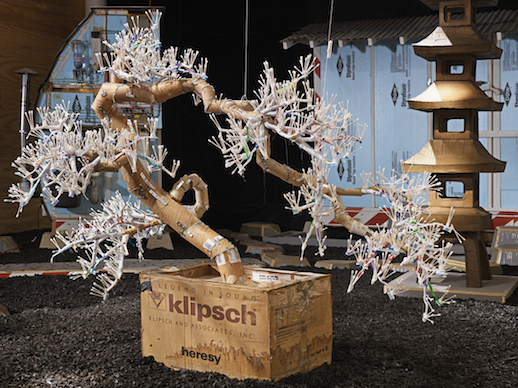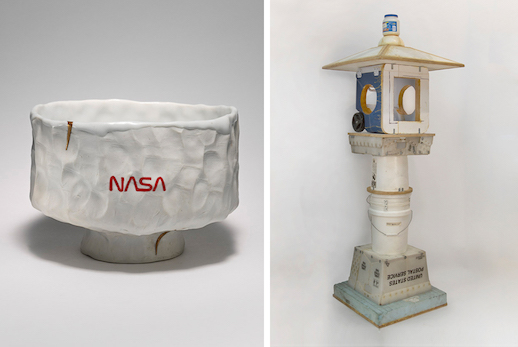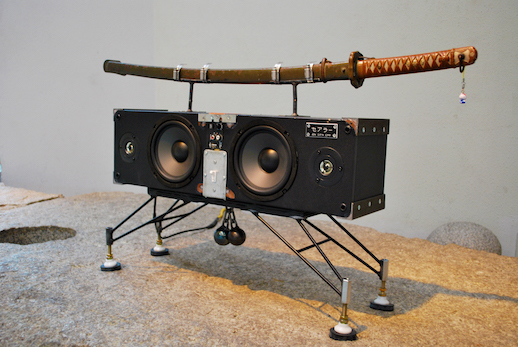Craftwork Heaven

Tom Sachs has been called many things throughout his 20-year career in the arts, from “creative polymath” and “DIY futurist” to a “cultural hybridizer”. At heart the New York-based artist is a “bricoleur”, a sculptor who infuses ordinary objects with magic through deliberately wonky craftsmanship. Sachs is in Japan at the moment to promote two shows, “The Universe and Art” at the Mori Art Museum and the Tomio Koyama Gallery-affiliated “Heaven” at the Sogetsu Kaikan, an ikebana center in Akasaka, Tokyo.
Both shows represent long-term passions in Sachs’ life: Japan and outer space. His obsession with space exploration has led him to create faux space missions to Mars and Europa, as well as works such as Crawler, a nearly 10-foot tall foamcore NASA space shuttle on display at “The Universe and Art”. His interest in Japan has manifested itself in pieces inspired by pop culture, Japanese historical figures and fellow sculptor Isamu Noguchi.
These themes of space voyage and Japanese culture crossed over in the first “Space Mission” exhibition in 2012 at the Park Avenue Armory; “Mars” featured astronauts on the surface of the Red Planet bonding over a reimagined tea ceremony, an idea Sachs revisited as part of his Japan-themed Tea Ceremony installation at the Noguchi Museum in New York earlier this year. He garnered much attention for the exhibition, which has laid the foundation for this current show in the Noguchi stone garden Heaven at the Sogetsu Kaikan complex.

As with the Brooklyn exhibition, the contrasts between Noguchi’s refined stonework and Sachs’ mixed media creations are striking, yet the multi-layered exhibition space here offers as many restrictions as it does possibilities. While the large-scale works such as the stone lantern Ishidoro (2013) and Bonsai (2015) fit perfectly in the landscape of the venue, some of the smaller items struggle to co-exist.
The two newest works on display, a Hermès Kelly bag and Perforated Cinderblock (both 2016), are fine examples of Sachs’ particular brand of bricolage, but fit less well with the overall theme of the show. Displays such as the motorized tea whisk Chasen (2015) and ritual tea bowls branded with the bright-red NASA logo will no doubt raise eyebrows from local tea ceremony practitioners. The extended set of items (including a cigarette lighter, a bottle of Jack Daniels and a Yoda Pez dispenser) may have been deemed too radical for Japanese audiences, but would have given a more complete sense of Sachs’ dedication to the project.

Many of the materials the artist has chosen may seem arbitrary, but there is an underlying streak of mischief visible with closer inspection. Sarah, a boombox which doubles as a samurai sword holder, is decorated with a tiny Hello Kitty phone charm and an inexplicable pair of dangling metal balls. Both Ishidoro and Kama (an iron pot) are topped with unusual items: a crunchy peanut butter container and an almost unnoticeable Yoda figurine head.
As they leave their classes and approach “Heaven”, Sogetsu ikebana students seem eager to take photos but are a little confused at the cultural crossover. No doubt Noguchi would have enjoyed discussing these reactions with Sachs over a cup of tea. As a foreigner, Sachs has a bit more freedom to explore this area, and will surely do so when he returns to Japan in the future. Further pairings with the Noguchi estate may still be possible, but attempts to collaborate with 21st century Japanese artists could open up whole new frontiers for him.
Paul Heaton
Paul Heaton


